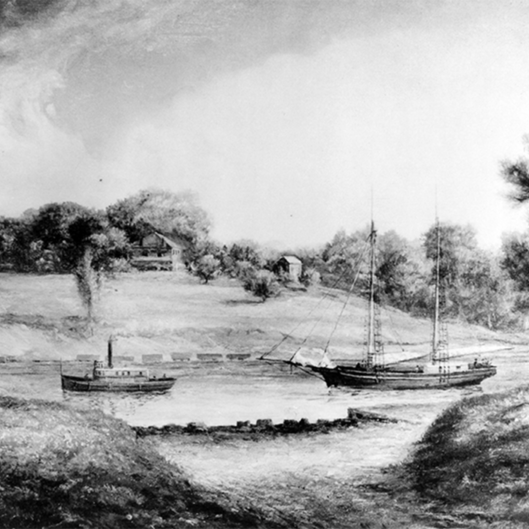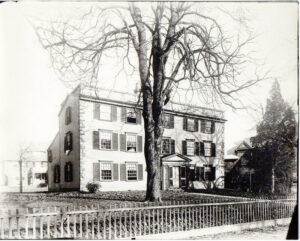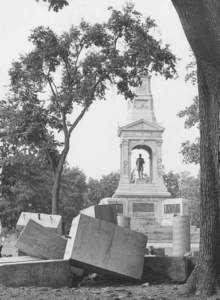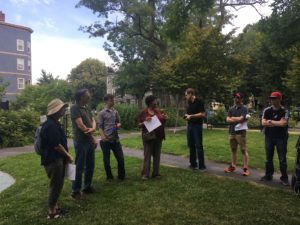
The War of 1812 sank trade in Cambridgeport, risking good livings at sea for Black residents
Above Image: Boats on the Charles River off Cambridgeport in the early 19th century. (Image: History Cambridge)
By Beth Folsom, 2023
At the turn of the 19th century, when Great Britain again found itself at war with France under Napoleon Bonaparte, the United States had been an independent nation for only two decades. President George Washington had long emphasized the importance of maintaining a neutral position with regard to conflicts between European countries, arguing that the nation was far too new and fragile to become entangled in others’ affairs. When Britain and France found themselves at war in the early 1800s, the United States’ neutrality policy led it to engage freely in trade with both sides in the conflict. This was particularly true for maritime trade, especially in cities such as Cambridge (and, in particular, the Cambridgeport neighborhood), where shipping was a key part of the economy.
Congress had designated Cambridge as a “port of delivery” in 1805, launching a boom in the sale of dock lots in the neighborhood and the dredging of coastal land for canal building. As the European conflict progressed, Britain and France tried to maintain a commercial relationship with the United States while preventing it from trading with their enemy. Landowners and merchants in Cambridgeport were eager to capitalize on this increasingly lucrative trade. The British and French navies, however, responded to attempts to trade with both sides by declaring U.S. ships fair game for capture. In addition, the British navy often sought to gain sailors for its warships via impressment – detaining U.S. sailors and merchant marines and forcing them into service. Although the British claimed merely to be seeking deserters from their own naval forces, in actuality they took the opportunity to capture and indenture American sailors as well.
President Thomas Jefferson signed the Embargo Act into law in 1807, imposing economic sanctions on Britain and France in an attempt to stop the capture of U.S. ships and the practice of impressment. The act prohibited American ships from engaging in foreign trade, and it closed all ports to ships from Britain and its colonies. The act proved extremely difficult to enforce, and its effects on the shipbuilders, port operators and merchants of places such as Cambridgeport were disastrous. The wealthy shipping elites of Cambridgeport joined their counterparts in cities up and down the East Coast in opposing the embargo, leading President James Madison to repeal the Act in 1809. After the repeal, American ships could once again trade with other nations (except for Britain and France); although many shipping centers began to see their fortunes improve, Cambridgeport was not able to recover.
Over the next several years, Madison and his diplomatic staff tried to reach a solution that would end the war in Europe and restore America’s trading relationship with Britain and France. They were unable to do so, however, and Madison delivered a declaration of war to Congress in June 1812. Lasting until 1815, the War of 1812 proved economically disastrous for Cambridge, and received little support from the politicians and prominent families of the entire New England region. But despite its unpopularity, one noteworthy Cambridgeport resident, Edmund Trowbridge Dana, made sure that the memory of the war would live on in many of the street names he gave to the land he inherited in the neighborhood. Dana’s father, lawyer and Massachusetts Supreme Court chief justice Francis Dana, was one of the primary investors in Cambridgeport’s development as a shipping center. The elder Dana had sustained heavy economic losses during and just after the Embargo Act and, when he died in 1811, much of his property was sold off to repay his debts. What remained was divided among his children, with Edmund Trowbridge Dana inheriting a tract of land in the middle of Cambridgeport. Despite his own lackluster military career, the younger Dana romanticized his service and honored the commanders, ships and battles of the War of 1812 in the street names he chose for the land he inherited.
Although much is known about the naming of these Cambridgeport streets and the people and events that inspired them, much less is known about the Black sailors – including those from Cambridge – who made up a significant portion of the U.S. navy and the merchant marine. Although enslavement was officially outlawed in Massachusetts in 1783, many Black residents found themselves in a system of de facto enslavement, technically “free” but with severely limited rights and few economic opportunities. For many Black men in and around Cambridge, jobs at sea proved more stable and lucrative than those on land, and many chose to work either on merchant ships or as crew on naval vessels.
Work aboard a ship guaranteed Black men shelter food, and pay, usually for at least several months at a time – security that many needed for themselves and their families but were often unable to secure on land. Moreover, Black sailors were offered the same pay as white sailors for the same position; although it was significantly more difficult for Black men to rise in the ranks than it was for their white counterparts, the appearance of equitable payment at the entry level attracted many Black sailors. Maritime work also provided Black sailors with training in skills and trades they could later translate to work on land, including cooking, carpentry and rope-making.
The military and diplomatic skirmishes of the early 19th century created greater opportunities for Black sailors, as shipowners and captains took any able-bodied men they could find, regardless of race. Service in the navy or the merchant marine provided Black men, including many from Cambridge, with opportunities for greater economic stability and more equitable treatment than they had in land-based occupations, and aided them in gaining skills and connections for their post-naval careers. Further exploration into the Black sailors of Cambridgeport during this period can enrich our understanding of the neighborhood, its people, and its place in maritime history.
For information about the War of 1812, its impact on Cambridgeport and the Black sailors of early 19th-century Massachusetts, see “The 1812 Streets of Cambridgeport” (Cambridge Historical Commission), “When the Port Was a Port” (History Cambridge) and “Black Sailors During the War of 1812” (U.S.S. Constitution Museum).
Beth Folsom is programs manager for History Cambridge.
This article was originally published in our “Did You Know?” column in Cambridge Day.






